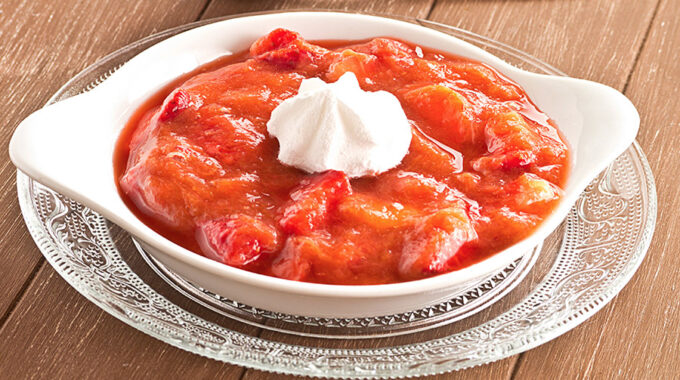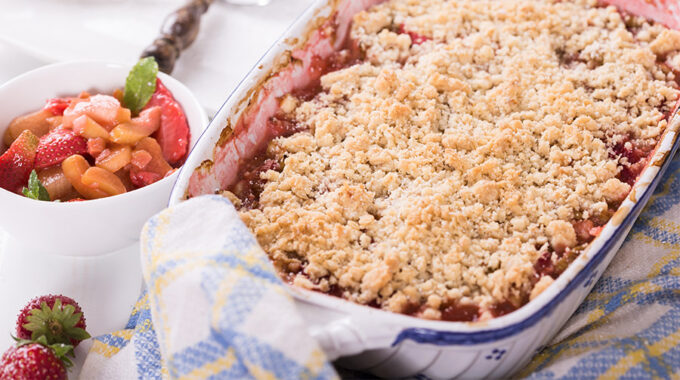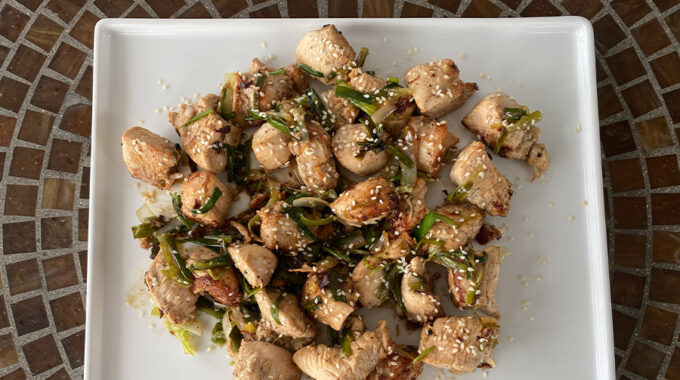Strawberry Rhubarb Compote by Norma Frye A compote or compôte (French for 'mixture') is a…
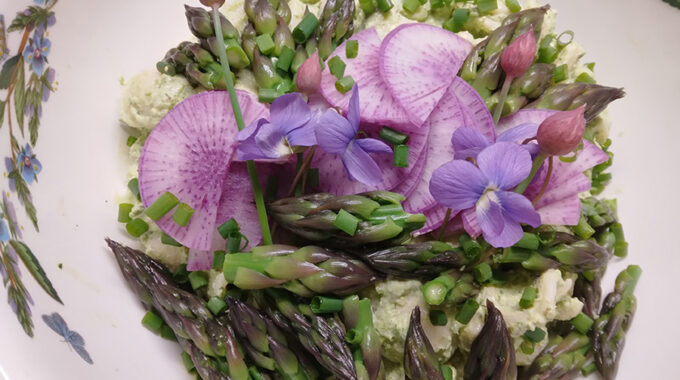
Recipe: Creamy Pesto Pasta Salad, Spring Version
By Ellen Green
The wait is over! Spring is here! There are leaves again! And here in Massachusetts, that means asparagus season, especially out in the Pioneer Valley where I grew up. Even way back when I was a kid before eating locally and seasonally got hip (okay, yes, I’m 30 and I’m talking about the ’90s, but stick with me here), it was always a special day when the farmstands would pop up on the side of the road like daylilies with the first real crop of the year. We’d only buy enough for dinner that night–the freshness of asparagus is measured in hours, or even minutes. Whatever else was on the table that night – since the first Asparagus Night was always a surprise, it might not have matched at all – there would be the special square platter with a pile of just barely cooked asparagus, butter melting down into the stack, and a lemon half to pass around. And we’d have asparagus at least twice a week until one day in June, when it stopped as suddenly as it began.
If you have perfect asparagus picked this morning, stop here–there is no better way to eat it. Steam until the stalks turn bright green, put some butter and lemon on it, eat. Or, if you’ve got the grill on, throw lightly oiled stalks on the hottest spot for maaaaybe a minute. But even for this asparagus lover, the novelty does wear off, and in any case, asparagus, like all of us, isn’t always at its best. Fortunately, asparagus is a pretty versatile vegetable – more or less anywhere you might put a crisp green bean, you can put asparagus, though it cooks a bit faster.
Asparagus also purees nicely, which is what we’re doing here. This is a version of the pesto pasta salad that I make a lot to showcase spring and summer vegetables. Hang onto it for later! In the spring, it’s all about the green stuff. In the summer, I like to serve it topped with caprese salad or veggie kabobs. Whatever season, it’s easy to make, easy on the eye, and easy to like, so perfect for parties. The one problem with the salad is that it doesn’t keep well. So I recommend only mixing up as much pasta with sauce as you need for one meal, and then storing extra pasta and sauce separately. Once you get to that point, it only takes a minute to finish. See the instructions for details.
Quick note on asparagus colors: purple and green asparagus can be used interchangeably – purple varieties won’t usually stay purple once cooked. I’ve never had white asparagus in my life (it’s green asparagus that’s been protected from sunlight as it grows), but in my opinion, it’s too fancy to puree.
Creamy Pesto Pasta Salad, Spring Version
Serves: serves 8-10 – hard to make a smaller batch, easy to make a bigger one (but see the notes if you’re cooking for fewer people)
Time: about 30 minutes active
Equipment: knife, cutting board, pasta pot, stove/hot plate, a fry basket or small metal strainer (recommended but not necessary), large colander, ice, small frying pan, clean towel, food processor, vegetable peeler, mixing bowl, big serving bowl, small zip-top bags or small jars (for freezing)
Ingredients
- 1 pound fresh asparagus
- 1 pound medium pasta (I used orecchiette today–shells, penne, and rotini work well. Use gluten-free or whole-grain pasta if you like.)
- ½ cup hazelnuts (preferred), walnuts, or pine nuts
- 2-4 large cloves of garlic, whole and unpeeled
- 1 oz basil leaves (a small package or a big handful), largest stems removed
- 1 small bunch parsley, largest stems cut off
- 3 oz hard Italian-style cheese, grated (I like Pecorino Romano here)
- 1 whole lemon, thoroughly scrubbed under warm water, plus up to 2 tbsp additional lemon juice
- ½ tsp salt, more to taste
- ½ tsp ground black pepper, more to taste
- ¼ cup olive oil, possibly more
- 2 cups yogurt or ricotta (see notes at bottom)
- a few tablespoons of buttermilk or milk
- fresh herbs, edible flowers, and seasonal vegetables to garnish (my photo has purple radish, violets, and chive flowers)
- balsamic or red wine vinegar, to serve
Directions
- Bring a big pot of lightly salted water to the boil. (If you don’t have a fry basket/small strainer, you might want to use 2 pots, one large for pasta and one small for asparagus.)
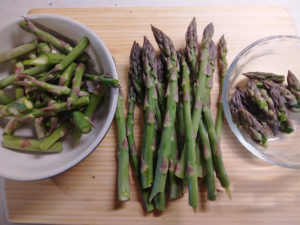 While you wait, prep the asparagus…
While you wait, prep the asparagus…
- Trim the ends off
- Rinse
- Snap off the tips, putting the nicer ones in one pile, dry or mushy ones in another
- Snap the stalks into 2 or 3 pieces and put them with the less beautiful tips
- Set up an ice bath – I’m known to cheat and just run stuff under cold tap water, but you really need an ice bath for this one!
- And toast the hazelnuts and garlic:
- Put the hazelnuts in a small, heavy pan over medium-high heat and toast until the nuts (not just the skins on the outside) are starting to brown. Pour them onto a clean towel and rub them vigorously to remove the brown skins – don’t get fussy about it, though, some skins are fine. Put the cleaned nuts in the food processor.
- Drop the whole, unpeeled garlic cloves in the same hot pan. Cook until they swell and break their skins, and the garlic clove softens and browns. Peel them and put them in the food processor.
- Once the water boils, put the asparagus tips into a fry basket or small strainer. Dunk the basket into the water, being careful not to let the asparagus escape. Wait 20 seconds, pull the asparagus out, and put it right into the ice bath. Once it’s cool, remove it from the ice bath and set it aside in the fridge.
- Cook the stalks the same way, but leave them in the water for 30-45 seconds, until they’re bright green and crisp-tender. Transfer to the ice bath, then to the food processor.
- Cook your pasta according to the package instructions–fully cook it, don’t stop at al dente. Drain the pasta and rinse under cold water until thoroughly cooled.
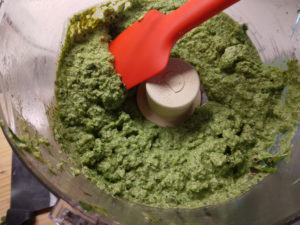 Peel the lemon with a vegetable peeler and put the peel into the food processor, along with the juice of half the lemon (you might need the other half, but taste first). Add the basil, parsley, cheese, salt, pepper, and olive oil to the processor. Pulse a few times until the pesto is roughly chopped, then run the food processor until the pesto is smooth. Add just enough olive oil to keep everything moving–the pesto should be quite thick, so don’t add more than necessary. Once it’s smooth, taste and adjust the flavors–more acid? More salt? More pepper? More cheese?
Peel the lemon with a vegetable peeler and put the peel into the food processor, along with the juice of half the lemon (you might need the other half, but taste first). Add the basil, parsley, cheese, salt, pepper, and olive oil to the processor. Pulse a few times until the pesto is roughly chopped, then run the food processor until the pesto is smooth. Add just enough olive oil to keep everything moving–the pesto should be quite thick, so don’t add more than necessary. Once it’s smooth, taste and adjust the flavors–more acid? More salt? More pepper? More cheese?- Put the pesto and yogurt/ricotta into a mixing bowl and stir until smooth. Season to taste–ricotta usually needs quite a bit of lemon juice. If you aren’t eating right away, put the sauce and the pasta in the fridge.
- Just before serving, fold the pasta and sauce together and add enough buttermilk to give you a glossy, smooth sauce. Top with the asparagus tips and garnishes. Serve at room temperature, and pass the vinegar at the table.
Serve with: grilled veggies and/or proteins, roast beef, lightly seasoned seafood, charcuterie and olives, falafel
Small batches: Make the full batch of pesto, then use the following proportions and refrigerate or freeze extra pesto:
- 2 servings: ½ cup pesto, ½ cup yogurt/ricotta, ¼ lb dry pasta
- 4: 1 cup, 1 cup, ½ lb
- 8: use the full recipe above
Freezing the pesto: Once you complete step 7, the pesto can be frozen for up to 6 months. Pack into zip-top bags and press all the air out; or pack tightly into small jars and top with half an inch of olive oil. Seal, date, and freeze. Use like you would any other pesto.
Yogurt or ricotta? Either one is good, but they’re very different. Yogurt will make a light, tangy sauce, which I like better for this asparagus version. Ricotta makes a very substantial, rich sauce that’s just a bit sweet–it lends itself more to being a main course, and is delightful with tomatoes. You could, of course, have it both ways and use half of each!Not asparagus season? Substitute 1 cup steamed and squeezed spinach, kale, or other greens for the asparagus, and proceed as usual.

